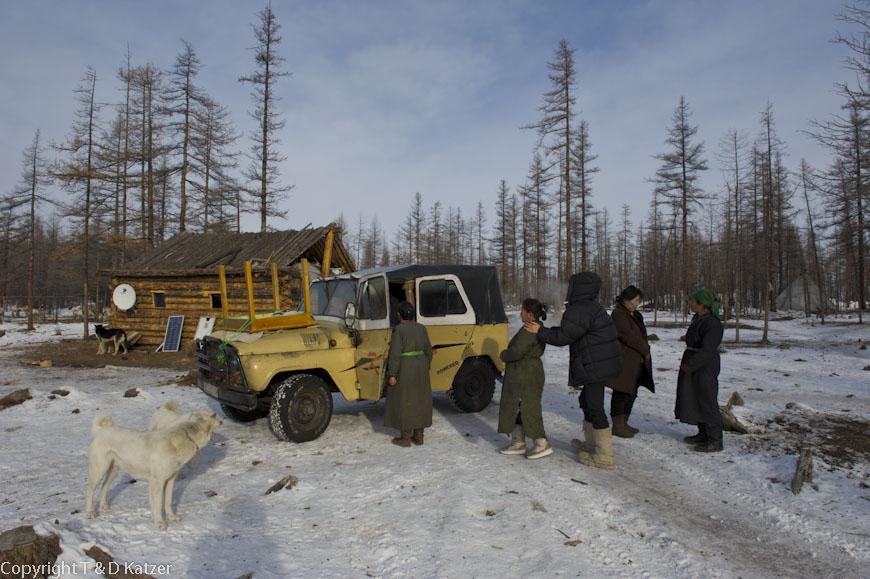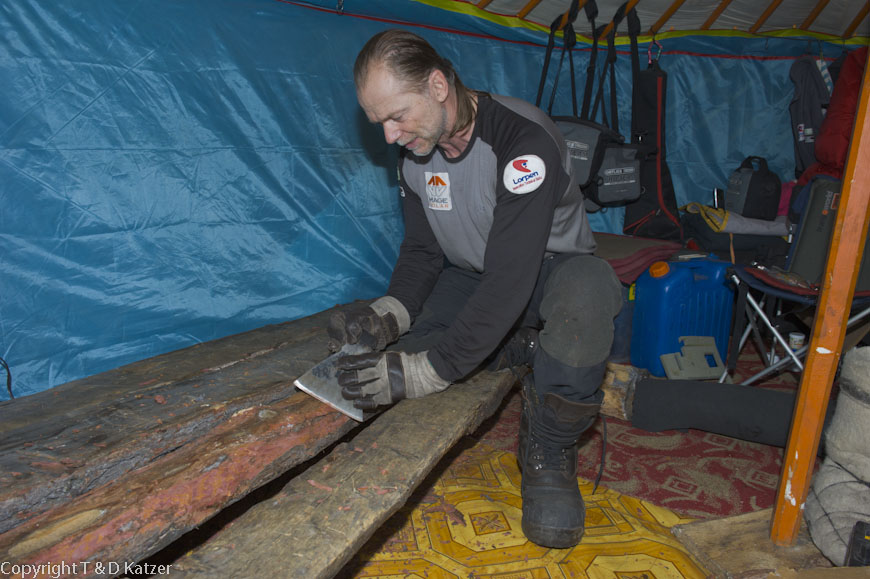
A lifetime of medication? – Reorganization – Mogi the acrobatic high diver – Bilgee’s Tuwa bed
N 51°33'336'' E 099°15'341''
Day: 243
Sunrise:
07:17
Sunset:
19:41
Total kilometers:
1281
Soil condition:
Ice, snow
Temperature – Day (maximum):
minus 5°C
Temperature – day (minimum):
minus 15°C
Temperature – Night:
minus 26°C
Latitude:
51°33’336”
Longitude:
099°15’341”
Maximum height:
1981 m above sea level



In the afternoon we have contact with Tsaya again. “The doctors say something different every day. After the current diagnosis, I am forced to take medication for the rest of my life. Because of the stillbirth of my child last year, I was given strong antibiotics over a long period of time. This supposedly enlarged my heart. I will be allowed to leave the hospital in a few days. I will then go to another hospital to get a second opinion. If the results are the same, I’ll have to accept that I won’t be able to work as usual for the rest of my life. It’s quite a shock to have to come to terms with a permanently diseased heart at my age,” she explains meekly. “Above all, it will be risky to want to live in the taiga with such heart damage,” I say to Tanja later. “Is she aware of that?” Tanja ponders. “I don’t know. She’s an intelligent woman. She wants to live out here at all costs. I just hope it doesn’t end up costing her her life,” I say sadly and sympathetically.
The next day we are gifted with bright sunshine again. “Land of the blue sky,” I say, stretching and inhaling the fresh air deep into my lungs. The day’s sun licks more and more of the thin snow fields. The daytime temperatures rise well above 0 °C in the sun and our remaining meat supply, which I had stored in a bag on the roof of the yurt, begins to thaw slightly. “We should bring the meat under the roof of Tsaya’s log cabin. There’s shade there and it won’t get frosty,” Tanja suggests. If the days really get warmer, I’ll bring our supplies there to safety. But so far, it’s just a small springtime project,” I reply.
Reorganization
We use the time to dismantle our yurt furnishings as far as possible and give Hoohod, Ultsan’s brother-in-law, who has driven a few Tuwa from Tsagaan Nuur to the taiga in his jeep, our table, two chairs and a few boxes. “Please take the stuff to Ayush. He will keep it for us in his shed. In a few days, when our horses reach Khatgal, we’ll call you and you can pick us and the rest of our belongings up,” we agree. Because there isn’t enough room in the jeep, he simply ties our table to the hood in Mongolian fashion. After the jeep with some of our household goods disappears behind the bare larch trees towards the village, Tanja takes care of the inventory of the remaining food. I, on the other hand, sort all our technology. We bring all the fuses and 220 volt chargers etc. to Tsagaan Nuur. We will only keep the bare essentials for our move to the spring camp. It’s a challenge for me because I can’t forget anything and still have to try to keep our solar-powered technology working. Our energy box and a spare car battery also remain on site. We will only use an 80 amp. Car battery and two large flexible solar panels. This should, I hope, provide us with enough energy for laptops, cameras and flashlights. Only when I’m sorting out do I realize what a luxury we have here in our beautiful yurt. Even though life in our felt house is spartan, we want for nothing. I already feel a little wistful when I think about having to leave this cozy castle.
Mogi the acrobatic high diver
I go for a walk with Mogi every late afternoon. Not without muzzling him. He now wears the muzzle of our deceased dog Rufus, who my mother sent to Mongolia about two months ago. It took many weeks for him to find his way from Mörön to our camp. During our 7,000 kilometer march through the Australian deserts, Rufus had to wear a muzzle because of the many poisoned baits. Farmers throw prepared meatballs from airplanes or off-road vehicles onto their land to control the dingoes. This was a life-threatening situation for Rufus. We promised our dog back then that he would survive the expedition and indeed he did. Mogi now carries the legacy of his Australian predecessor. But every day he makes me understand that he could happily do without such an inheritance. “If you don’t want to be shot by some angry Mongol because of your passion for hunting, the muzzle is the only option. This thing is your life insurance,” I explain to him. Mogi looks at me with his big eyes and pretends he doesn’t understand a thing. “I want to hunt and bite sheep, goats, young cows and anything that runs away from me in the ass,” he barks.
Wearing his face armor, he throws himself into the snow and ploughs through the white, just as he did in late summer. He actually managed to free himself from her twice in this way. Now Tanja has sewn in another strap that makes it impossible for Mogi to get rid of his mouth helmet. “Come on, Mogi. Give it up already!” I shout to him as we run through the forest. “Never!” he barks at me, leaping into the air like a high diver, only to plummet head first into the snow like a kamikaze a fraction of a second later. Then he plows a long path through the white until he crashes his head into one of the many tree trunks. Confused, he looks up, shakes himself, only to do his aerial pirouette again. He lands with a crash in the hard snow with his maul to cut another swathe through the taiga. “You’re a damn stubborn donkey!” I shout and run on while Mogi now combines his acrobatic actions with the powers of a sumo wrestler. He grabs the annoying thing in front of his face with both paws and tugs at it. Any normal muzzle would fall apart by now at the latest. Thank God Rufus’ legacy is welded from good steel. Mogi has no chance of tearing the leather straps holding the thing to his neck or breaking the steel. He has been wearing the muzzle for two weeks now and every day he starts the fight all over again. I have never seen a dog so stubborn and stubborn. I’m really looking forward to seeing what it’s like when we’re out and about with our horses again and can only hope that he doesn’t somehow manage to do the impossible and free himself from the biting inhibitor.
Bilgee’s Tuwa bed
Tanja often walks to an abandoned Tuwa camp 1 ½ kilometers from our yurt. From there she drags in old wooden beams. “Good firewood,” I praise my wife enthusiastically. “No firewood. You can build a bed for Bilgee out of it. Then he won’t have to sleep on the floor when we have to wait a few more days for the nomads to leave for the spring camp. “Do you think it’s worth the effort? It will only be a few days at most.” “You’re not going to let our man sleep on the floor while we make ourselves comfortable on the Wandan, are you?” “You think that would be humiliating for him?” “Yes.” “Okay, then I’ll make a bed. Hope he appreciates that. When Tanja has brought enough beams and roughly hewn boards, I get to work. I shorten the logs, which have been sawn in half, to two meters, work on the uneven areas with the axe and drag them into the yurt. Then I lay them each on a log about 15 centimetres thick and shortened to 90 centimetres. So that the boards are at a distance from the yurt floor. “It looks really good,” praises Tanja. “Still wobbles like a cow’s tail,” I reply, carrying the heavy planks back outside to work on them again with the axe. I do this until the boards rest firmly on my logs. I fix them to the round trunks with large nails, lay a felt mat over them and the bed is ready. “Perfect. Looks just like the sleeping quarters the Tuwas have in their tipis. I think Bilgee will be delighted,” says Tanja enthusiastically. “I hope,” I reply proudly of my work. Without the table and the two chairs, we now have more space than before. I think our yurt is even more beautiful and original now,” says Tanja.
Snowfall, April weather
No incidents yet,
Bilgee has not yet heard back from Khatgal
We look forward to your comments!

